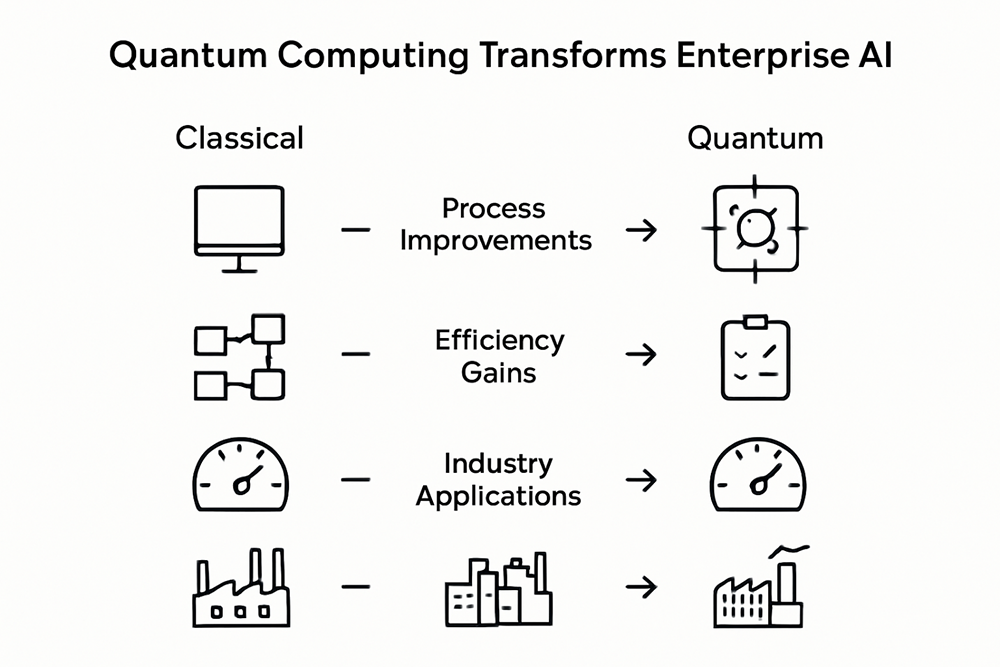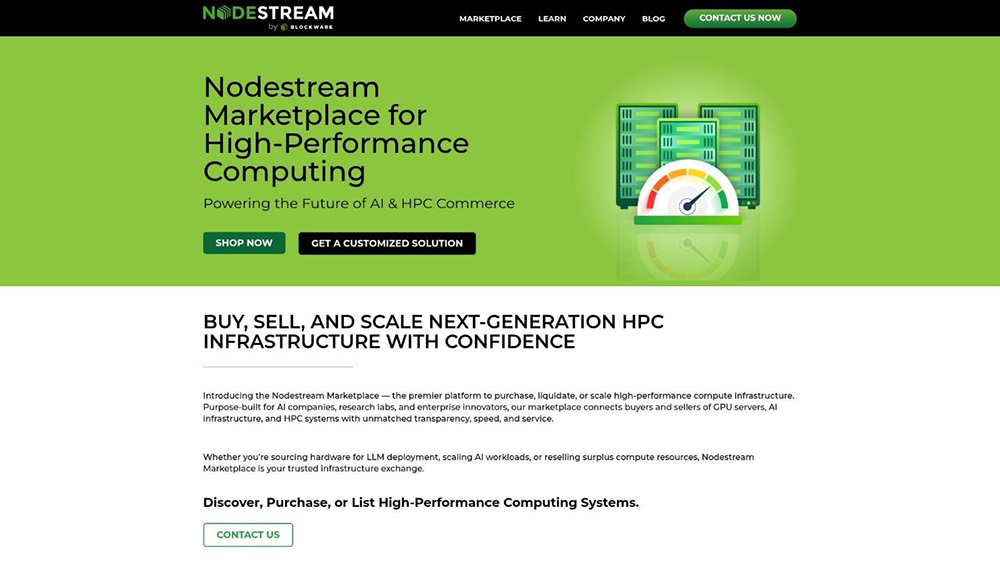
Quantum computing is about to flip enterprise technology upside down. Get this. The US government is pumping $65 million into quantum research and some quantum algorithms are predicted to cut AI complexity by orders of magnitude. At first glance, it all sounds futuristic and out of reach. What most people miss is that the race for quantum readiness is not only underway but the practical steps and new hardware shifts are being put in place right now.
| Takeaway | Explanation |
|---|---|
| Quantum computing will enhance enterprise AI capabilities. | Integrating quantum algorithms can significantly improve AI performance, allowing organizations to tackle complex problems efficiently and effectively. |
| Invest in workforce training for quantum technologies. | Organizations need to develop talent in areas like quantum physics and computer science to prepare for future quantum transitions. |
| Establish quantum governance frameworks. | Creating robust governance structures ensures organizations can manage risks and integrate quantum technology into their cybersecurity strategies effectively. |
| Prioritize cryptographic resilience against quantum threats. | Organizations must assess vulnerability to quantum decryption and develop adaptive cryptographic solutions to secure their data effectively. |
| Adopt distributed quantum computing architectures. | Transitioning to distributed systems can improve the scalability and performance of quantum computing, enhancing overall computational capacity and flexibility. |

The convergence of quantum computing and artificial intelligence represents a transformative technological frontier that will fundamentally reshape enterprise capabilities. By leveraging quantum mechanics principles, organizations can unlock unprecedented computational power and solve complex problems that traditional computing architectures cannot address.
Quantum computing introduces radical computational approaches that transcend classical computing limitations. Innovative quantum algorithms demonstrate extraordinary potential for accelerating machine learning processes, enabling enterprises to tackle intricate optimization challenges with remarkable efficiency. These algorithms can process multidimensional data sets exponentially faster than conventional systems, presenting unprecedented opportunities for advanced pattern recognition and predictive modeling.
Research from IBM Quantum Computing Labs suggests quantum machine learning models could potentially reduce computational complexity by orders of magnitude. This breakthrough means enterprises can develop more sophisticated AI systems capable of handling previously insurmountable computational challenges, such as complex financial modeling, advanced drug discovery simulations, and intricate supply chain optimization strategies.
Quantum computing introduces a paradigm shift in computational sustainability. Recent research demonstrates how integrating quantum technologies with classical machine learning can dramatically reduce energy consumption and carbon emissions associated with high-performance computing infrastructure.
Enterprises adopting quantum-enhanced AI systems can expect significant improvements in computational efficiency. By utilizing quantum principles, organizations can develop more energy-efficient algorithms that minimize resource consumption while maximizing computational output. This approach not only reduces operational costs but also aligns with emerging environmental sustainability goals.
Successful quantum AI integration requires strategic planning and a comprehensive understanding of emerging technologies. Cutting-edge research proposes hardware-agnostic frameworks that enable seamless quantum computing adoption across diverse enterprise environments.
Organizations must invest in workforce training, develop quantum-compatible infrastructure, and cultivate interdisciplinary teams capable of bridging quantum mechanics, computer science, and domain-specific expertise. Learn more about advanced computing infrastructure to understand the evolving landscape of high-performance computational technologies.
The future of enterprise AI lies not in replacing existing systems but in strategically augmenting them with quantum capabilities. By embracing this technological revolution, forward-thinking organizations can gain unprecedented competitive advantages, solve complex global challenges, and drive innovation across multiple industries.
To help illustrate the comparison between classical and quantum-enhanced AI capabilities, the following table summarizes some of the key differences highlighted in this section.
| Aspect | Classical AI | Quantum-Enhanced AI |
|---|---|---|
| Computational Speed | Limited by binary operations | Exponentially faster for certain tasks |
| Problem Complexity | Struggles with highly complex/multidimensional problems | Can tackle intricate optimization, pattern recognition, and simulations |
| Energy Efficiency | High energy/resource usage | Reduced energy consumption via quantum algorithms |
| Scalability | Incremental, hardware-dependent | Scales efficiently with quantum principles |
| AI Applications | Traditional ML, analytics | Advanced modeling: finance, drug discovery, supply chain |
The quantum computing hardware landscape in 2025 is experiencing unprecedented transformation, with groundbreaking developments poised to redefine computational capabilities across enterprise environments. Emerging technologies are rapidly bridging the gap between theoretical potential and practical implementation, setting the stage for a revolutionary computational paradigm.
Distributed Quantum Computing Architectures
Quantum computing is evolving beyond isolated systems toward sophisticated distributed architectures. Innovative research introduced a breakthrough distributed quantum computing framework that integrates advanced techniques like entanglement buffering, asynchronous entanglement generation, and adaptive scheduling. These architectural innovations dramatically enhance system performance and scalability.
The distributed approach allows quantum systems to overcome traditional limitations by creating interconnected computational networks. Organizations can now leverage multiple quantum processors working collaboratively, effectively multiplying computational power while maintaining complex quantum coherence. This methodology represents a significant leap forward in creating more robust and flexible quantum computing infrastructure.
Government initiatives are playing a critical role in quantum computing hardware development. The U.S. Department of Energy recently allocated $65 million specifically targeting quantum computing research. This substantial investment focuses on critical areas including advanced software development, sophisticated control systems, and algorithmic innovations essential for creating scalable quantum technologies.
These strategic investments signal a profound commitment to establishing comprehensive quantum computing infrastructure. By funding fundamental research and development, governments are creating ecosystems that support rapid technological progression. The emphasis extends beyond pure hardware development to include crucial supporting technologies that will enable practical quantum computing implementations across various sectors.
As quantum computing capabilities expand, critical cybersecurity considerations emerge. A recent Government Accountability Office report highlighted potential risks quantum computing poses to existing cryptographic systems within the next decade. This underscores the urgent need for hardware designs that not only advance computational capabilities but also integrate robust security mechanisms.
Enterprise organizations must anticipate these challenges by developing quantum-resistant hardware architectures. This involves creating systems capable of maintaining computational integrity while implementing advanced encryption methodologies that can withstand potential quantum decryption attempts. Explore advanced computing infrastructure strategies to understand how emerging technologies are addressing these complex technological transitions.
The quantum computing hardware landscape of 2025 represents a critical inflection point. By combining distributed architectures, strategic national investments, and proactive security considerations, the industry is laying the groundwork for a transformative computational future that promises unprecedented problem-solving capabilities across scientific, commercial, and technological domains.
The integration of quantum computing into high-performance computing (HPC) and data center environments represents a transformative technological frontier that promises to revolutionize computational capabilities across complex scientific and enterprise workloads. As organizations seek to push the boundaries of computational performance, quantum technologies are emerging as a critical solution for addressing increasingly sophisticated computational challenges.
Cutting-edge research has introduced groundbreaking hardware-agnostic frameworks that enable seamless quantum computing integration within classical scientific high-performance computing systems. These innovative approaches focus on strategically augmenting existing HPC infrastructure with quantum computational capabilities, creating hybrid computing environments that maximize computational efficiency and problem-solving potential.
The proposed integration methodologies go beyond simple replacement, instead creating sophisticated computational ecosystems where quantum and classical computing resources work collaboratively. A comprehensive software stack architecture supports this integration, providing a unified resource management system that can handle both current noisy intermediate-scale quantum devices and future fault-tolerant quantum computers.
Quantum computing integration requires advanced resource management strategies that can effectively coordinate heterogeneous computational resources. Innovative research has developed a suite of plugins for Slurm workload management systems, enabling seamless incorporation of on-premises and cloud-based quantum computing resources into existing high-performance compute clusters.
These technological advancements allow data centers to create more flexible and dynamic computational environments. Organizations can now dynamically allocate and schedule quantum and classical computing resources based on specific workload requirements, optimizing computational efficiency and reducing overall infrastructure costs. Learn more about advanced HPC infrastructure strategies to understand the evolving landscape of computational technologies.
While quantum integration presents extraordinary opportunities, it also introduces complex technical and operational challenges. Data centers must develop robust strategies for managing quantum hardware’s unique requirements, including advanced cooling systems, precise error correction mechanisms, and specialized infrastructure designed to maintain quantum coherence.
Enterprise organizations must also invest in workforce training and development, cultivating interdisciplinary teams capable of managing these sophisticated hybrid computational environments. This involves creating educational programs that bridge quantum mechanics, computer science, and domain-specific expertise.
The future of data center and HPC infrastructure lies in creating adaptive, flexible computational ecosystems that can seamlessly integrate emerging quantum technologies. By embracing these innovative integration strategies, organizations can unlock unprecedented computational capabilities, solve complex global challenges, and drive technological innovation across multiple domains.
Below is a summary table outlining key components and challenges for integrating quantum computing into data centers and HPC environments as detailed in this section.
| Component / Challenge | Description |
|---|---|
| Hardware-Agnostic Frameworks | Enable seamless integration of quantum into classical HPC systems |
| Software Stack Architecture | Facilitates unified management of quantum and classical resources |
| Resource Management | Dynamic allocation/scheduling across quantum and classical systems |
| Plugins for Slurm | Integrate quantum hardware via familiar HPC workload manager |
| Specialized Infrastructure | Cooling, error correction, and systems to maintain coherence |
| Interdisciplinary Teams | Workforce with physics, CS, and domain knowledge |

As quantum computing transitions from theoretical potential to practical implementation, organizations must proactively develop comprehensive strategies to harness and mitigate this transformative technology. The quantum era demands a strategic, multifaceted approach that goes beyond traditional technological preparation.
The World Economic Forum recommends a structured approach to quantum preparedness, emphasizing the critical importance of establishing robust governance frameworks. Organizations must create dedicated quantum risk management structures that integrate quantum considerations into existing cybersecurity and technological strategies.
This involves developing cross-functional teams capable of understanding quantum mechanics, cybersecurity implications, and organizational technology needs. Leadership must prioritize quantum literacy, ensuring decision-makers comprehend both the potential opportunities and significant risks associated with quantum technologies. By creating a comprehensive quantum governance model, organizations can systematically assess, monitor, and respond to emerging quantum challenges.
According to SGInnovate, building internal quantum expertise represents a fundamental preparatory step. Organizations must invest in talent acquisition and development strategies that cultivate quantum-specific skills across multiple disciplines including physics, computer science, cryptography, and domain-specific technological applications.
This talent strategy involves multiple approaches: developing internal training programs, establishing partnerships with academic institutions, creating quantum research internships, and recruiting professionals with interdisciplinary backgrounds. Learn more about advanced computing infrastructure strategies to understand how cutting-edge organizations are preparing their workforce for quantum transitions.
Quantum computing poses significant challenges to existing cryptographic systems, necessitating a proactive approach to technological resilience. Organizations must conduct comprehensive risk assessments that evaluate current technological infrastructures’ vulnerability to potential quantum decryption capabilities.
Key steps include implementing post-quantum cryptographic protocols, utilizing mathematical modeling to simulate potential quantum threats, and developing flexible ‘crypto-agile’ systems that can rapidly adapt to emerging security paradigms. This involves not just technological modifications but a strategic approach to understanding and mitigating potential quantum-related cybersecurity risks.
The quantum preparation journey is not a destination but a continuous process of learning, adaptation, and strategic innovation. Organizations that develop holistic, forward-thinking approaches to quantum technologies will be best positioned to transform potential disruptions into competitive advantages. By combining rigorous governance, strategic talent development, and technological resilience, enterprises can navigate the complex quantum landscape with confidence and vision.
Quantum computing leverages principles of quantum mechanics to perform calculations at unprecedented speeds, allowing enterprises to solve complex problems that traditional computers cannot. This technology is expected to significantly enhance AI capabilities and improve operational efficiencies.
Quantum algorithms can process multidimensional datasets exponentially faster than classical systems, enabling organizations to develop more sophisticated AI systems. This can lead to enhanced capabilities in areas such as advanced modeling, predictive analytics, and optimization problems.
By 2025, quantum computing is expected to feature distributed architectures that enhance scalability and performance. National investments in quantum infrastructure and innovations in cybersecurity measures for quantum hardware will also be pivotal in this evolution.
Organizations should establish quantum governance frameworks, invest in workforce training to develop quantum-specific skills, and assess their cryptographic resilience against potential quantum threats. This proactive strategy will enable them to harness the benefits of quantum technology effectively.
Quantum computing is moving from bold ideas to practical reality, but most organizations face stumbling blocks when it comes to upgrading their AI and HPC infrastructure. The article highlights the urgent need for scalable hardware, seamless quantum-classical integration, and future-proof high-performance solutions. Meanwhile, enterprises are under pressure to invest in technology that keeps pace with quantum advancements, without slowing down current operations or taking disruptive risks.
If you are searching for real solutions to bridge this gap, Nodestream by Blockware Solutions is ready to help. Our verified marketplace empowers you to quickly access powerful HPC and AI-ready infrastructure for quantum workloads, remove bottlenecks in deployment, and support hybrid system scaling with customized, secure transactions. Bulk purchasing, real-time inventory, and enterprise support eliminate the uncertainty in next-generation hardware procurement.

Don’t let your organization fall behind in the race toward quantum-driven innovation. Visit Nodestream today to discover how our transparent marketplace can help your team buy, sell, or scale the infrastructure needed for advanced computing demands. Explore your options now and move from strategy to action before the competition does.